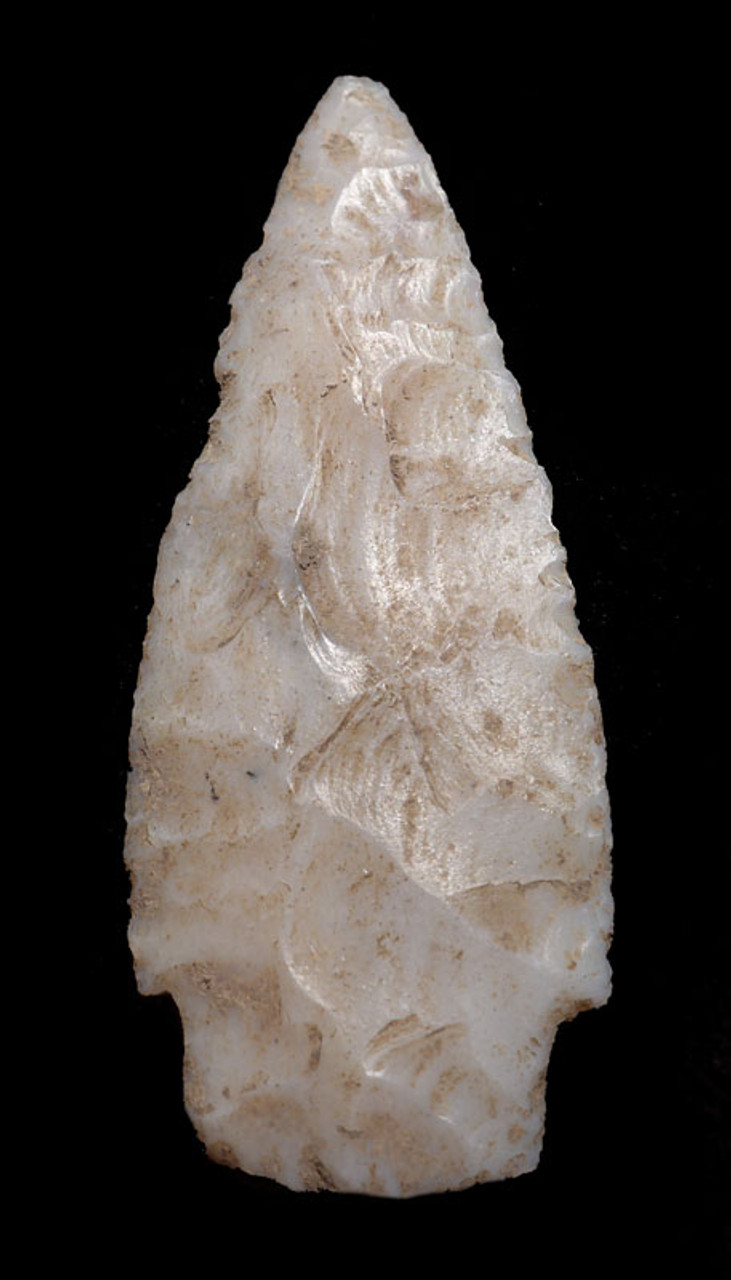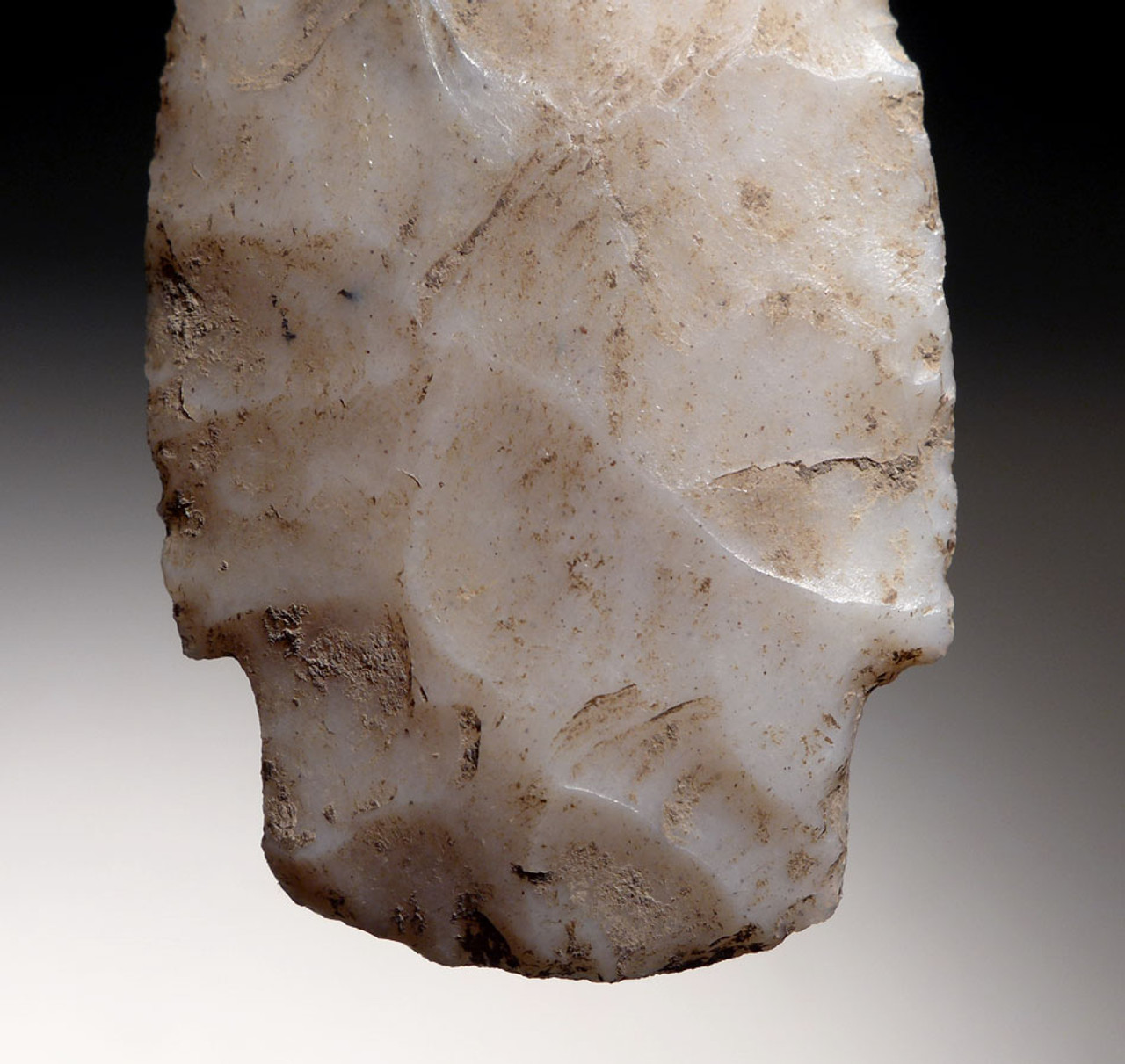Product Description
ID
|
Weapon
|
||
FOUND
|
Central America
|
||
AGE
|
Post Classic Period:
|
||
SIZE
|
3" long x .15" thick
|
||
CONDITION
|
INTACT WITH NO REPAIR
|
||
NOTE
|
PRESTIGE PIECE WITH
|
||
INCLUDES DISPLAY BOX - Actual Item - One Only
|
|||
Made of RARE white flint, this MASTERFULLY flaked large bifacial atlatl spearhead is from the Pre-Columbian Aztec Culture. Most certainly cherished in ancient times as a prestige weapon, there is obvious evidence of use and ancient re-sharpening on the cutting edges of both sides. What is amazing is how thin this projectile point is, despite its broad profile. It would have taken a true master flintknapper to make such an object! In this time and culture, most projectile points were black obsidian so one made of WHITE flint and of this size, most certainly meant that its owner was either of a noble class or a soldier of a prestigious unit or close to their ruler. This is an absolutely top-shelf, gem-grade specimen in every way! INTACT WITH NO REPAIR OR RESTORATION OR ALTERATIONS. Mineral and sediment can be seen deep in microscopic crevices which are indicators ONLY found in AUTHENTIC specimens such as this.
The Atlatl or Spear (Dart) Thrower was a weapon used to hurl darts called "tlacochtli" with greater force and from greater range than they could be thrown by hand. This weapon was considered by the Aztecs to be suited only for royalty and the most elite warriors in the army, and was usually depicted as being the weapon of the Gods. Murals at Teotihuacan show warriors using this effective weapon and it is characteristic of the Mesoamerican cultures of central Mexico. Warriors at the front lines of the army would carry the atlatl and about three to five throwing darts which they would launch after waves of arrows and sling projectiles as they advanced into battle before engaging into melee combat. The "darts" launched from an Atlatl were more like big arrows about 5.9 feet long. Tipped with obsidian, chert, bone or copper heads.
The origin of the Aztec (Azteca) Empire is legendary. Aztec codices record that they began their wandering journey in 1100 A.D. emerging from their former homeland called Aztlan or "place of the herons", an island in a lake where men went out to fish from boats. The exact location of this region is not known but other than it was northwest of present-day Mexico City, the former center of the Aztec empire, but how far, it is a mystery.
While many ancient civilizations remain a mystery, little can be left to conjecture when it comes to the details of the Aztec way of life. An extensive and detailed collection of written and pictorial records exist for us today called CODICES (CODEX if singular) were produced before Spanish contact by the native tribes themselves, and afterwards during the Colonial period. These codices were created by the Aztecs in pictorial form, as well as by other indigenous tribal sources, all of which had no written language. Colonial era codices exist in greater number with roughly 500 separate codices known, showing extensive pictograms as well as being written in Spanish, Latin and in the original Nahuatl language.
The Aztecas believed they were guided by a blood-thirsty deity they called Huitzilopochtli who communicated to them through four priest-chieftains called teomama. Their god called upon them for his insatiable thirst for human blood and sacrifice. As they migrated south, every indigenous Indian tribe they encountered along the way abhorred the Azteca, as they were known, as they were reviled and scorned for their violent and barbaric ways. During their migration, Huitzilopochtli gave a message to his people that their new identity would no longer be known as Azteca but as Mexica. In around 1325 A.D., as they were fleeing an altercation with the Culhuacans, they were driven to a marsh. Their god Huitzilopochtli consoled them that evening and said he would end their wandering and told them to look for a sign that he will give them that will signify their new homeland which will be "the place of the cactus and the eagle I now name Tenochtitlan". They next day they witnessed an eagle resting on a prickly pear cactus which they interpreted to be the sign they were hoping for.
This marsh, Lake Texcoco, would later become a vast canal-laced highly advanced, super city of stone pyramids and temples known as Tenochtitlan. With a population that grew to an estimated 200,000 people (three times the largest city of Spain at the time!) this became the center of the most powerful and militaristic empire of Mesoamerica - home of the Aztecs. Today, we classify their reign as occupying the Late Post Classic Period from 1250 - 1521 A.D.
The success and rise of the Aztec empire was largely attributed to their dominance through intimidation of their surrounding neighbors from whom they extracted resources from. The effect of their extreme militarism and brutality on their enemies brought a large region of peoples into submission. The highly advanced and complex Aztec social structure, as well as legal system, kept their growth intact and the society orderly. They formed an alliance with the Texcoco and Tlacopan tribes and in 1428 A.D., they defeated the Tepaneca. This triple alliance established a great empire that was predominantly ruled from Tenochtitlan. At its peak, this empire included a large, diverse group of people and spanned an area from the entire Central Mexico region south, into northern Guatemala.
 US DOLLAR
US DOLLAR
 EURO
EURO
 AUSTRALIAN DOLLAR
AUSTRALIAN DOLLAR
 CANADIAN DOLLAR
CANADIAN DOLLAR
 POUND STERLING
POUND STERLING














